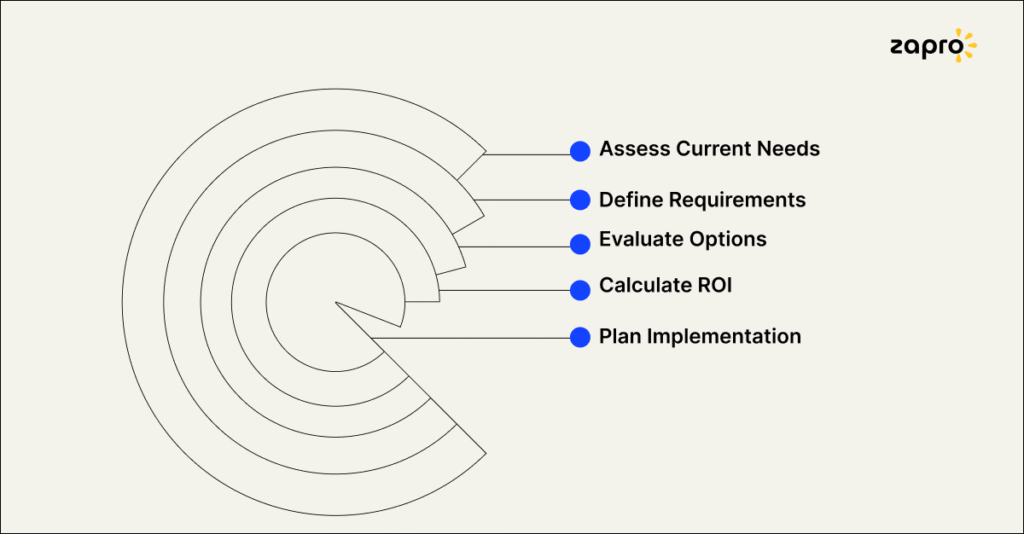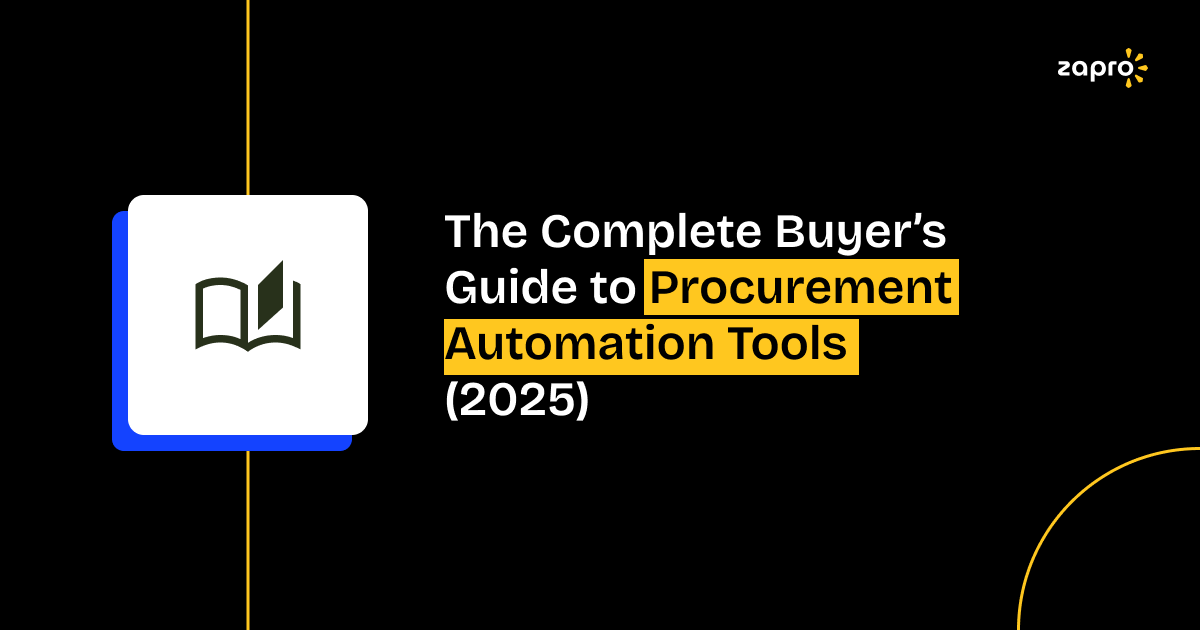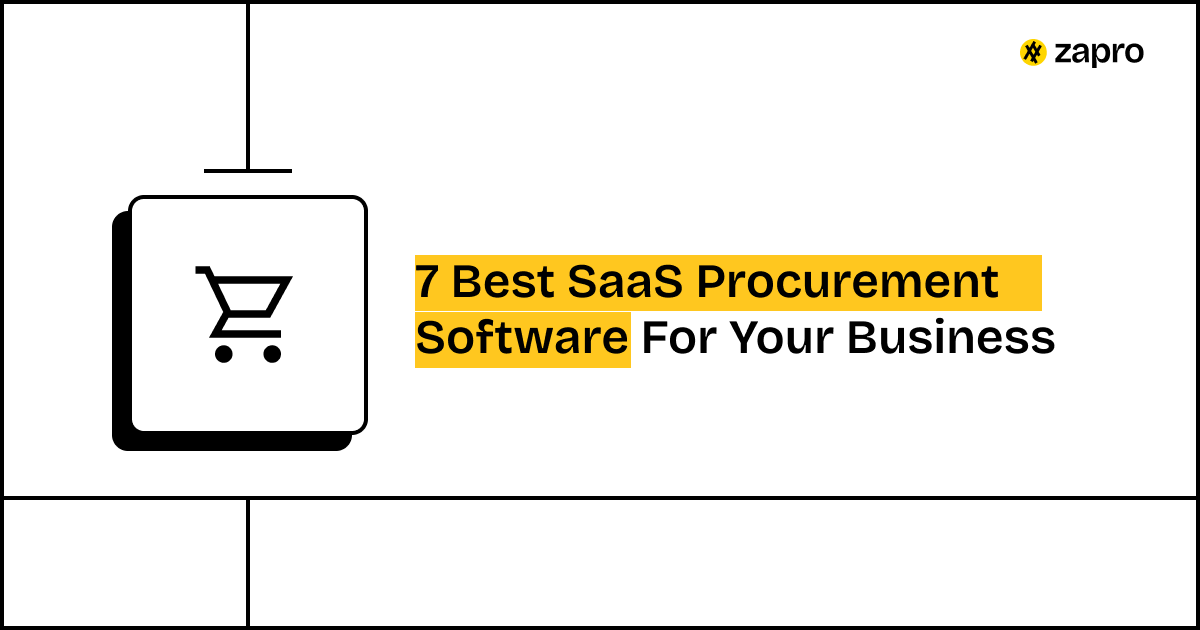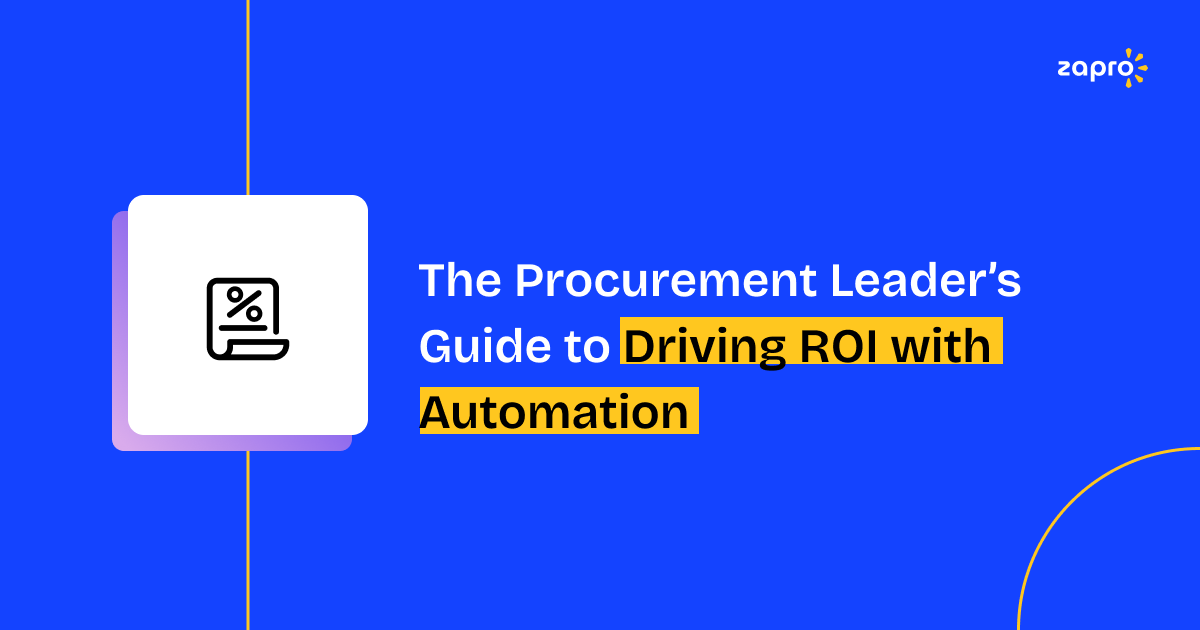Introduction
According to a latest study, businesses that use procurement automation tools are able to process faster by 45% and enjoy 23% cost reductions compared to manual workflows.
While many businesses have procurement software in place, its efficiency helps them with sending and receiving emails, maintaining spreadsheets, and approval platforms. However, they are unaware of the fact that they are missing out big on savings, induced frustration among employees, and minimal vendor management. Replacing with the right automation software, the business can touch new heights by transforming procurement into a strategic growth driver.
Having said that, in this blog post, we will bring to light about the nature of top procurement automation tools, the features that you need to look for, evaluation steps, pricing comparisons, and the solutions leading the market in 2025.
By the end, you’ll have a clear understanding to pick the right procurement automation software that best-fits your business needs and implement it for a greater rewarding cause.
What Are Procurement Automation Tools?
Basically, procurement automation software’s sole purpose is to ease the buying process from end-to-end. Starting from the step approach of raising a purchase request to the end of final payment and delivery, it is there to make it uncomplicated, make it a lot quicker, and keep it transparent at all stages. Some of the benefits of implementing procurement software is that it automates spreadsheets, email conversations, and invoice checks, through rule-based workflows that run in the background seamlessly.
Think about how procurement usually works without automation. An employee fills out a request form, sends it to their manager for approval, waits days for a response, and then finance still needs to verify the details manually. Vendor onboarding requires sending contracts back and forth, and matching invoices to purchase orders can turn into a headache.
Here is what procurement management tools will do for you:
- No more waiting for approvals; requests are sent automatically through predefined rules. So, no time is wasted on waiting for signatures or email approvals.
- No manual intervention is required to generate Purchase orders. They are created instantaneously, without any mistakes, and with great precision through built-in policy checks and real-time budget enforcement.
- Onboard vendors digitally without missing out on any of the joining formalities. Track everything related to the vendors in one place
- Map the invoices automatically with Purchase Orders and Receipts, and eliminate the fear of delay or manual errors.
Procurement automation empowers your business to transform in a big way without the fear of getting dropped in errors, slower cycle times, or paperwork. Also, equip the decision-makers in the company with key insights about every dollar spent.
Learn more about procurement policy.
Types of Procurement Automation Tools
There are numerous types of Procurement Automation Software that are available in the market. Each one has a greater purpose to attend to while some fit-in with any type of requirement. Make sure you pick the one that comes packing the most common categories, and that includes:
1. Workflow automation tools
Every-bit of your business process flow is automated in accordance with the compliance and applies business rules to reduce bottlenecks.
Best choices include:
- Zapro.ai: AI-powered workflows that route approvals instantly.
- Kissflow Procurement Cloud: Simple, no-code workflow automation.
- Pipefy: Customizable procurement and approval workflows
2. Vendor management automation
Onboard your suppliers with ease. Never miss the compliance part and effortlessly track their SLA (service-level agreement).
Best choices include:
- Zapro.ai: Auto-generates POs with built-in policy checks.
- Precoro: Easy PO management for small and mid-sized teams.
- Procurify: Real-time PO creation with budget visibility.
3. Purchase order automation software
Know what is spent and evade all kinds of surprise in the month-end. Integrate with product catalogs and generate Purchase Orders automatically. Don’t wait for manual approvals.
Best choices include:
- Zapro.ai: Digital onboarding with compliance tracking.
- Jaggaer: Supplier lifecycle management at scale.
- SAP Ariba Supplier Management: Comprehensive vendor data and compliance tools.
4. Procure-to-pay automation tools
Take control of everything from invoice to payment. Effortlessly maintain finances accurate and ready for audits.
Best choices include:
- Zapro.ai: Full-cycle procure-to-pay with 5-day implementation.
- Coupa: Enterprise-grade procure-to-pay automation.
- Oracle Procurement Cloud: Strong for complex enterprise processes.
The procurement process is fast and elegant when the right procurement automation tool is put to use. It ensures smoothness by connecting systems and other essential parts in the wheel. Businesses can save time, money, and resources and also, gain the agility to scale operations without adding complexity.
Learn more about purchase order management tools.

The procurement software market is projected to grow from USD 8.65 billion in 2024 to USD 9.81 billion in 2025, at a compound annual growth rate (CAGR) of 13.5 %.
Essential Features in Procurement Automation Software
Procurement automation tools have a lot of features and it is wise to stay away from getting lost in the features. Here are the top features that are commonly seen in every good Procurement automation tool you will come across. Here they are:
1. Workflow automation
This feature is the most important of all, and it is the core feature that any procurement automation tool will have. With this, effortlessly move requests through right channels and don’t wait for approvals or email threads. Set the rules and monitor on the go, get intimated when someone misses a step and follow up with them quickly without any delay.
2. Purchase order automation
Delays occur when purchase order management are manually done, so automate them. Ensure zero mistakes by setting the rules, generate POs in one click, pull items from approved catalogs, and keep every purchase aligned with budgets. It is fast, accurate, and ensures you never spend outside of approved limits.
3. Vendor management automation
Onboarding suppliers should never be a prolonged process which consumes days or weeks. Automate the vendor management, collect all the information hassle-free and upload to track all the movements of the supplier on performance dashboard hassle-free. This way, you’ll not only speed up the vendor automation process, but also be establishing long-lasting relationships and trust with the vendors.
4. Procure-to-pay automation
Speed up payments by digitally capturing invoices and mapping them to POs in no-time. Do away the long waits with procure-to-pay automation, keeps vendors happy, and eliminates costly errors.
5. Analytics and reporting
Get real-time analytics and know when the funds go out and for what purpose. Have clear visibility and easily find out if there are any unusal activities before it poses a threat. Insights about procurement transactions will help turn into a strategic advantage rather than just an operational function.
With Zapro.ai, all of these features come out of the box enhanced by AI-driven insights, 300+ integrations, and audit-ready compliance. It’s designed for growing businesses that want enterprise-level procurement automation without the complexity or steep price tag.
Learn about Top Affordable Purchasing Software for Small Businesses in 2025
Tips for Selecting Procurement Automation Tools

Choosing the right procurement automation tools is a challenging task, as it can prove to be very resourceful for smoothening of the entire process and overall growth. The best approach to zero-in on the perfect procurement automation tools is to have a clear understanding of your business needs.
For more insights, check this step-by-step framework to guide your selection process:
1. Assess current needs
The best way to get started is by understanding the hiccups and roadblocks that you face in the procurement process. Say for example:
- Approvals getting stuck in endless email chains?
- Invoice mismatches causing payment delays?
- Supplier churn is costing time and money to the organization?
Learning about your pain points helps narrow down to the right tools that solve real problems, not just add shiny features.
2. Define requirements
Not all procurement management tools are built the same. While one can be good at advanced analytics, the other can be good at purchase order automation software or vendor management automation. Therefore, before making your final decision, find out if it has the features what you need. In other words, pick the perfect one for your business, make a list of what is required. Say for example, something like this:
- Compliance Tracking
- PO Automation
- Procure-to-pay workflows
This way, you won’t get distracted by bells and whistles that don’t add immediate value.
Learn about Best Purchase Order Software of 2025.
3. Evaluate options
After the requirements have been completely jotted down, it’s time to request for demos. Book demos with different procurement software providers!
Your main aim is to find out how easily they integrate with your existing ERP or accounting systems. Also, the usability factor shouldn’t be forgotten. If the interface isn’t user-friendly, how expensive your procurement automation tool is, the teams are going to struggle at it.
4. Calculate ROI
Return on Investment is the key to learning about your big success; likewise, Automation is an investment that should pay for itself. This can be calculated by comparing the cost of the tool with expected savings from faster cycle times, reduced invoice errors, and stronger supplier discounts. A good procure-to-pay automation tool would deliver ROI within months, not years.
5. Plan implementation
Pay attention in the implementation part, a good software has a solid rollout plan. Ask for a realistic timeline, make sure your team gets proper training, and prepare for change management. Phased rollouts (starting with purchase orders or invoice automation first) often work best, allowing teams to adjust gradually.
Decision criteria: At the end of the day, the right procurement automation software is the one that balances functionality, cost, ease of implementation, and the quality of ongoing support. A system that ticks all these boxes will not only solve your current challenges but also scale with your business as it grows.
Learn about best procure to pay software.
Pricing & ROI Analysis
Procurement Software Pricing Models
When it comes to procurement automation tools, pricing can vary depending on the size of your business, how many transactions you handle, and the level of features you need. Generally, you’ll come across three common pricing models:
- Per-user pricing: This is the most straightforward model. You pay a monthly fee for each person using the platform, typically ranging between $15–$100 per user per month. This works well for small to mid-sized businesses where usage is predictable.
- Transaction-based pricing: Instead of paying per user, some platforms charge based on the number of transactions processed. Costs usually fall in the $2–$10 per transaction range. This model makes sense if your team is small but processes a large volume of purchase orders, invoices, or supplier payments.
- Enterprise pricing: Larger organizations with complex supply chains often need advanced features, custom integrations, and high-volume support. In such cases, vendors provide custom quotes tailored to the business’s scale and requirements.
ROI Benchmarks You Can Expect
While pricing is important, what really matters is the return on investment (ROI). The right procurement software pays for itself quickly by reducing inefficiencies and unlocking cost savings. Here’s what most businesses experience after implementation:
- 3–6x ROI within the first year: The software not only saves time but also identifies spend leaks and captures negotiated supplier discounts.
- 20–40% reduction in costs: Automation eliminates duplicate purchases, late payment penalties, and over-reliance on manual labor.
- 50–80% faster processing times: Approvals, purchase order creation, and invoice matching that once took days now happen in minutes.
Why Zapro Stands Out
Many solutions promise automation, but few deliver results as quickly and affordably as Zapro. With plans starting at just $15 per user per month, Zapro offers enterprise-grade procurement automation without the hefty price tag. Even better, Zapro is known for the fastest implementation in the market, just 5 days meaning you can start seeing savings and efficiency gains almost immediately.
Comparison of the Best Procurement Automation Tools in 2025
Choosing the right procurement automation tools often comes down to comparing the strengths of leading platforms. Each solution has its own sweet spot—some are better for small and growing businesses, while others cater to large, complex enterprises with global supply chains. Below is a closer look at the top purchase-to-pay automation software platforms for 2025:
1. Zapro
Zapro is built for small to mid-sized businesses that want the power of enterprise-grade procurement automation without the overwhelming complexity or high price tag. With more than 300 integrations, Zapro brings together intake, purchase order creation, approvals, vendor management, and compliance into one smooth, AI-powered workflow.
The biggest advantage? Speed. Zapro’s implementation can be completed in as little as 5 days, compared to months with other platforms. Plus, it comes with a 90-day satisfaction guarantee, making it a risk-free choice. At just $15 per user per month, Zapro is not only affordable but also delivers unmatched value for SMBs and mid-market companies looking to automate fast and grow smarter.
2. SAP Ariba
SAP Ariba is a global giant in the procurement automation space, designed primarily for large enterprises with complex supply chains. Its strength lies in connecting buyers and suppliers through one of the world’s largest digital business networks. Ariba offers end-to-end procurement, contract management, and supplier collaboration features.
However, the platform comes with a steep learning curve and higher pricing, making it less ideal for smaller organizations. Implementation can also be long and resource-heavy, but for global enterprises needing advanced functionality, SAP Ariba remains a strong choice.
3. Coupa
Coupa has made a name for itself with its focus on spend visibility and expense management. It empowers businesses to gain full control over their procurement and financial operations through real-time analytics and user-friendly dashboards.
Coupa is particularly strong for mid-to-large enterprises that want tighter control of budgets and supplier relationships. While it provides a wide range of procurement management tools, it can take significant effort to configure the platform to fit your organization’s processes. For companies willing to invest the time, Coupa delivers powerful insights and measurable savings.
4. Oracle Procurement Cloud
Oracle Procurement Cloud is a natural choice for companies already operating within the Oracle ecosystem. It offers seamless integration with Oracle ERP and finance tools, making it a strong option for enterprises that want a unified system.
The platform includes advanced features for reporting, compliance, and supplier collaboration, and is designed to handle the scale of enterprise-level operations. While Oracle Procurement Cloud is feature-rich, it can be costly and may not be the best fit for smaller teams due to its complexity.
5. Jaggaer
Jaggaer is particularly well-regarded in industries like higher education, manufacturing, and government, where vendor management and compliance are critical. Its platform offers robust tools for sourcing, contract management, and supplier lifecycle management, making it a reliable option for organizations with specialized procurement needs.
Jaggaer’s strength lies in its ability to manage complex supplier ecosystems and provide deep visibility into vendor performance. However, like SAP Ariba and Oracle, it is often better suited to larger organizations with the resources to support its advanced setup and ongoing management.
Comparison Table
| Platform | Starting Price | Key Features | Best For | Implementation Time |
| Zapro.ai | $15/user/month | AI-powered automation, 300+ integrations, PO + vendor mgmt | SMBs & mid-market | 5 days |
| SAP Ariba | Custom | Global supplier network, P2P automation | Large enterprises | 3–6 months |
| Coupa | Custom | Spend management, analytics | Mid-large firms | 2–4 months |
| Oracle | Custom | Procurement + finance suite integration | Enterprises | 3–6 months |
| Jaggaer | Custom | Vendor mgmt, sourcing, P2P | Specialized industries | 2–4 months |
Learn more about Best Procurement Software Platforms For 2025
How to Successfully Deploy Procurement Automation Tools
Even the best procurement automation tools can fall short if they aren’t implemented the right way. The technology itself is powerful, but success depends on how well it’s rolled out across your organization. Here are some practical steps to make sure your deployment delivers maximum impact:
1. Secure executive sponsorship and align on objectives
Leadership buy-in is critical. When executives champion the project and clearly communicate its goals like reducing cycle times or improving spend visibility teams are far more likely to support and adopt the new system.
2. Roll out in phases, not all at once
Instead of overwhelming your team, start with the most impactful area such as purchase order automation software. Once that’s running smoothly, expand to vendor management automation and procure-to-pay automation. This phased approach builds confidence and delivers quick wins.
3. Invest in comprehensive user training
No tool will succeed if people don’t know how to use it. Provide hands-on training sessions, create easy-to-follow guides, and set up support channels. The easier the platform feels, the faster your team will embrace it.
Conclusion & Next Steps
Procurement automation tools are no longer a luxury; they’re a necessity for businesses looking to scale efficiently. From workflow automation to vendor management automation and procure-to-pay solutions, the right platform will reduce costs, speed up processes, and give your business the visibility it needs to grow.
If you’re looking for a tool that balances enterprise-grade features, fast implementation, and affordable pricing, Zapro is your best bet.
Get Started with Smarter Procurement Today.

FAQs
1. What is procurement automation and how does it work?
Procurement automation is the use of technology, mainly AI-driven workflows and procurement automation tools to handle tasks that are traditionally manual, repetitive, and error-prone. Instead of employees sending endless approval emails, creating purchase orders in spreadsheets, or manually matching invoices, automation takes care of these steps seamlessly. For example, a purchase order automation software can automatically generate POs once requests are approved, while procure-to-pay automation tools can match invoices against contracts and release payments instantly. This not only speeds up the process but also reduces errors, ensures compliance, and gives businesses more control over spending.
2. What does procurement automation software typically cost?
The cost of procurement automation software varies depending on the size of the business, the number of users, and the features included. For small to medium-sized businesses, most procurement management tools start at around $15 per user per month, making them affordable for growing teams. Larger enterprises with complex procurement often go for custom enterprise pricing models that are tailored to their specific workflows and transaction volumes. Some vendors also offer transaction-based pricing (e.g., $2–$10 per transaction), which can be cost-effective for companies with fluctuating procurement activity.
3. What are the must-have features in procurement automation software?
The perfect tool will come sporting the must-have features that every business needs. These features are:
- Purchase order automation software: Automatically generate and manage POs with catalog integration.
- Vendor management automation: Digital supplier onboarding, SLA tracking, and performance monitoring.
- Procure-to-pay automation tools: End-to-end workflows from requisition to invoice payments.
- Procurement analytics: Real-time spend visibility, compliance monitoring, and forecasting.
- ERP integration: Smooth connection with your accounting, finance, or HR systems.
4. What’s the typical implementation timeline for procurement automation?
The timeline for implementation of procurement automation tools may vary. Ideally, for plug-and-play solutions like Zapro.ai, five days is enough to get started with minimal disruption. On the other hand, large-scale platforms can take 3 to 6 months to fully implement because of their complexity, customization, and integration requirements. Furthermore, it could also be impacted by company size, number of days required to train the employees, etc.,
5. Which procurement automation platforms are leading the market in 2025?
The procurement automation platforms that are leading the market in 2025 are:
- Zapro.ai: Latest entrant in the market packing best of features. Well suited for SMBs, mid-market and enterprise type. Super-fast implementation is its best advantage and 300+ integrations.
- SAP Ariba: It is cloud-based management software which businesses use to streamline their procurement processes and overcome procurement challenges. Best-suited for enterprise type.
- Coupa: Strong spend management and analytics capabilities that may be used by companies with heterogeneous IT environments.
- Oracle Procurement Cloud: Procurement Cloud modernizes procurement business processes, its ideal for companies already using Oracle’s ecosystem.
- Jaggaer: Formerly known as SciQuest, it is recognized for industry-specific procurement solutions like higher education and manufacturing.
These procurement management tools are shaping the future of procurement by combining automation, AI, and analytics to deliver speed, cost savings, and smarter decision-making.
Don’t miss our weekly updates
We’ll email you 1-3 times per week—and never share your information.

 Healthcare
Healthcare Financial Services
Financial Services Technology
Technology Venture Capitalist
Venture Capitalist Chief Procurement Officer
Chief Procurement Officer Chief Financial Officer
Chief Financial Officer




